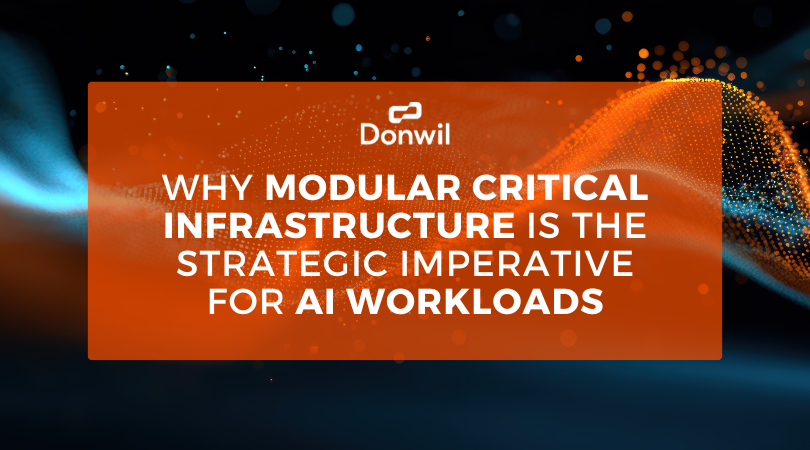AI is no longer something on the horizon. It’s already reshaping how we operate, how we compete, and how we design the environments that power it all.
At Donwil, we’ve spent decades helping organizations build and protect critical infrastructure. We know what works, and we know what breaks under pressure. And right now, we’re seeing too many facilities try to support cutting-edge AI workloads with outdated, rigid systems. It doesn’t work.
Modular infrastructure is the only smart, future-ready approach to AI. Here’s why.
Why Modular Critical Infrastructure is the Strategic Imperative for AI Workloads
The age of Artificial Intelligence isn’t just changing how businesses operate; it’s fundamentally redefining the very foundation upon which our digital world rests. At Donwil, we’re witnessing firsthand how the insatiable demands of AI are forcing a paradigm shift in data center and mission-critical environments. High-density workloads, the imperative for real-time processing, and escalating energy consumption aren’t merely presenting challenges—they’re unveiling unprecedented opportunities for organizations ready to embrace a more adaptive infrastructure model. Modular critical infrastructure has evolved from a progressive idea to an absolute necessity.
The AI Tsunami: Unprecedented Demands on Infrastructure
The computational DNA of Artificial Intelligence workloads is vastly different from traditional IT operations. AI, particularly the explosion of generative AI and large language models, requires infrastructure built for a new era of intensity and agility.
Consider these critical demands:
- Massive Compute Power: Training and inference for complex AI models necessitate an astronomical amount of processing capability, often relying on power-hungry GPUs and specialized accelerators.
- Real-Time Responsiveness: From edge AI applications to operational intelligence, the need for immediate data processing and ultra-low latency is paramount. Delays can translate directly into lost insights, missed opportunities, or critical system failures.
- Extreme Density: To consolidate powerful processors and optimize performance, AI workloads demand high-density rack configurations that push the boundaries of traditional data center design.
- Advanced Thermal Management: The sheer heat generated by these high-density components requires sophisticated and efficient cooling solutions, moving beyond conventional air cooling to advanced liquid cooling techniques.
- Scalable Power and Cooling Systems: The dynamic and often unpredictable growth of AI initiatives means infrastructure must be able to scale power and cooling capacity rapidly and without disruption.
- Robust Networking: Moving vast datasets between storage, memory, and compute nodes at high frequency is crucial, requiring high-bandwidth, low-latency network architectures.
Legacy infrastructure, with its rigid systems, fixed capacities, and lengthy deployment cycles, simply cannot keep pace with the velocity of AI innovation. The traditional “build big and wait” approach is a thing of the past.
Why Modular Infrastructure is the Answer
Modular critical infrastructure isn’t just a trend; it’s a strategic response to the unique demands of AI. It delivers the agility, efficiency, and resilience that are non-negotiable in the age of AI. Here’s why a modular approach is the intelligent choice for forward-thinking organizations:
1. Scalability by Design: Grow as You Go
AI initiatives rarely start at their full scale. They often begin with pilot projects, proof-of-concepts, and then explode in demand. Modular systems, such as prefabricated power and cooling modules, enable organizations to start small and expand seamlessly as needs evolve. This eliminates costly overbuilding, reduces initial capital expenditure, and ensures resources are deployed precisely when and where they’re needed. It’s about optimizing resource allocation, not just maximizing capacity.
2. Accelerated Time-to-Value: Speed as a Competitive Advantage
In the race for AI dominance, speed is a critical differentiator. Modular components are pre-engineered, factory-tested, and shipped ready for rapid deployment. This translates to significantly faster installation times, minimal on-site disruption, and a quicker realization of value from your AI investments. For AI applications where every day counts, this accelerated deployment cycle provides a tangible competitive edge.
3. High-Density Optimization: Powering the Core of AI
From specialized rack power distribution units to precision cooling solutions, modular infrastructure is explicitly optimized for high-density environments. Whether you’re integrating the latest GPUs, TPUs, or advanced processors, modular systems ensure your facility can support their maximum performance without compromising uptime or operational efficiency. This proactive design prevents bottlenecks before they even emerge.
4. Advanced Thermal Management: Taming the Heat
AI workloads push thermal boundaries like never before. Modular systems are inherently flexible, allowing for seamless integration of advanced cooling technologies. This includes direct-to-chip liquid cooling, rear door heat exchangers, and even immersive cooling solutions. This adaptability future-proofs your infrastructure, preparing it for the even higher thermal demands of next-generation AI hardware.
5. Energy Efficiency and Sustainability: A Responsible Approach
With modular infrastructure, you can deploy right-sized power and cooling that directly aligns with your actual workload demands. This precise allocation leads to significant energy savings, a reduced environmental footprint, and demonstrable support for your organization’s broader sustainability goals. It’s not just about meeting demand; it’s about doing so responsibly and efficiently.
6. Built-In Resilience and Redundancy: Ensuring Uninterrupted AI
For critical AI applications, uptime is non-negotiable. Modular systems are engineered with built-in redundancy and failover capabilities, ensuring your AI applications remain online and available even in the face of equipment failure or fluctuating demand. This inherent resilience minimizes risk and protects valuable AI processes.
7. Future-Proof Flexibility: Adapting to the Unknown
The pace of AI evolution is relentless. A modular approach provides the ultimate flexibility to swap components, integrate new solutions, and adapt your environment without requiring major, disruptive renovations. This agility ensures your infrastructure can evolve as rapidly as AI technology itself, safeguarding your investment and preventing obsolescence.
Real-World Application: AI Meets Modular in the Data Center
At Donwil, we partner with organizations across the region to design and build future-ready critical environments. By leveraging modular solutions from trusted partners like Vertiv, we ensure your infrastructure can not only keep up with your current AI ambition but also scale to meet future, unforeseen demands.

